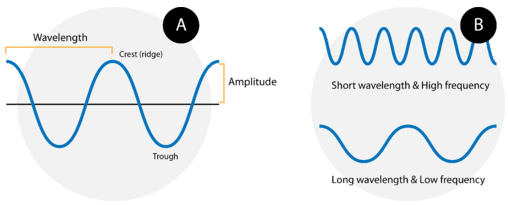
Waves
 المؤلف:
LibreTexts Project
المؤلف:
LibreTexts Project
 المصدر:
................
المصدر:
................
 الجزء والصفحة:
.................
الجزء والصفحة:
.................
 12-8-2020
12-8-2020
 1611
1611
Waves
Waves are characterized by their repetitive motion. Imagine a toy boat riding the waves in a wave pool. As the water wave passes under the boat, it moves up and down in a regular and repeated fashion. While the wave travels horizontally, the boat only travels vertically up and down. The figure below shows two examples of waves.

Figure 1 : (A) A wave consists of alternation crests and troughs. The wavelength (λ)
is defined as the distance between any two consecutive identical points on the waveform. The amplitude is the height of the wave. (B) A wave with a short wavelength (top) has a high frequency because more waves pass a given point in a certain amount of time. A wave with a longer wavelength (bottom) has a lower frequency.
A wave cycle consists of one complete wave - starting at the zero point, going up to a wave crest, going back down to a wave trough, and back to the zero point again. The wavelength of a wave is the distance between any two corresponding points on adjacent waves. It is easiest to visualize the wavelength of a wave as the distance from one wave crest to the next. In an equation, wavelength is represented by the Greek letter lambda (λ)
. Depending on the type of wave, wavelength can be measured in meters, centimeters, or nanometers (1m=109nm). The frequency, represented by the Greek letter nu (ν), is the number of waves that pass a certain point in a specified amount of time. Typically, frequency is measured in units of cycles per second or waves per second. One wave per second is also called a Hertz (Hz) and in SI units is a reciprocal second (s−1).
Figure B above shows an important relationship between the wavelength and frequency of a wave. The top wave clearly has a shorter wavelength than the second wave. However, if you picture yourself at a stationary point watching these waves pass by, more waves of the first kind would pass by in a given amount of time. Thus the frequency of the first wave is greater than that of the second wave. Wavelength and frequency are therefore inversely related. As the wavelength of a wave increases, its frequency decreases. The equation that relates the two is:
c=λν (1)
The variable c is the speed of light. For the relationship to hold mathematically, if the speed of light is used in m/s, the wavelength must be in meters and the frequency in Hertz.
 الاكثر قراءة في كيمياء عامة
الاكثر قراءة في كيمياء عامة
 اخر الاخبار
اخر الاخبار
اخبار العتبة العباسية المقدسة


